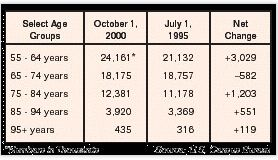The 2000 Census and other U.S. Census Bureau studies contain a wealth of information of interest to gift, estate, and financial planners alike. Consider the following:
- U.S. population grew by over 13% to 281 million since the 1990 Census.
- Every state’s population grew for the first time since the 1870s.
- The median age of Americans increased, while the over-85 age group swelled over 40% during the past decade from 3 million to 4.2 million.
- Households consisting of a married couple with no children increased, as did single households.
- Between 1970 and 2000, the average size of households decreased from 3.14 to 2.62 persons.
- Home ownership rates reached record levels, with 2 out of 3 households owning their homes.

This Census data is likely to fuel the continued interest in planned giving as the potential pool of persons who are most likely to make substantial gifts in this manner grows. The number of older persons with no or few children is reportedly on the rise. The Census data may lend additional credence to the Boston College wealth transfer study, which projected as much as $41 trillion or more in estate transfers over the next five decades, with record amounts left to charities. Note, however, that the aging of America is uneven and, as reported in the February 2001 issue of Give & Take, there has been a shrinkage in the 65-75 age group as a result of lower birth rates between 1925 and 1935.
Making use of the data
While the Census data release may hold general interest, astute financial development executives will recognize that this information can be carefully utilized to positively impact their development efforts. It may be difficult, however, to use the information to gain more than general insights about the overall donor population.
The 2000 Census is based upon individual household information, but that data is compiled into over 8 million “blocks,” or neighborhood groupings. To maintain household confidentiality, Census Bureau statisticians use a number of techniques, such as data swapping among households within a “block,” to mask the identity of individual households. It will also be some time before the new Census data is generally available for use in the enhancement of marketing efforts. This means that many organizations that are utilizing Census track data for marketing purposes are still using information that is based on the older 1990 Census.
Great expectations
The 2000 Census data contains invaluable information for those making gift planning marketing decisions. For example, knowing that over 75% of households in one state own their homes as opposed to approximately 40% in another may affect the way a gift planner makes list selections for communications that focus on gifts of remainder interests in homes. Similarly, knowing which states have the greatest percentages of elderly residents may influence who receives bequest or gift annuity mailings. For the best effect, though, these statistics should be analyzed in conjunction with information that you already know about your donors. In addition to traditional gift frequency, longevity, and amount analysis, other factors such as age or wealth rating may enhance your gift marketing selections.
The key to effective marketing is reaching the right people at the right times in their lives with the right gift opportunity. The new Census data is one more tool you can use to refine your selection in hopes of increasing the success of your gift planning efforts. For more information on the 2000 Census, visit the Census Bureau’s Web site at www.census.gov.

